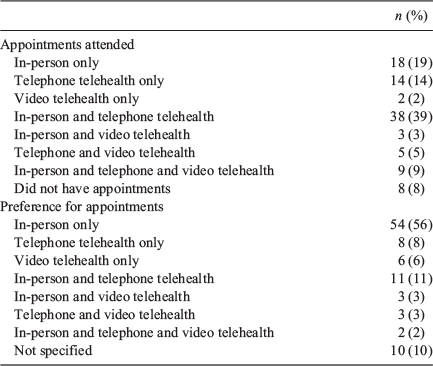‘Nothing beats the doctor’s face to impart trust in their judgement’: the role of telehealth in cancer care
Neli S. Slavova-Azmanova A B , Lesley Millar A , Angela Ives A and Christobel M. Saunders AA UWA Medical School, The University of Western Australia, Perth, WA, Australia. Email: lesley.millar@uwa.edu.au; angela.ives@uwa.edu.au; christobel.saunders@uwa.edu.au
B Corresponding author. Email: neli.slavova-azmanova@uwa.edu.au
Australian Health Review 45(4) 521-522 https://doi.org/10.1071/AH20314
Submitted: 1 November 2020 Accepted: 29 December 2020 Published: 15 February 2021
Journal Compilation © AHHA 2021 Open Access CC BY
Abstract
Despite Western Australia having low COVID-19 case numbers and limited community transmission, cancer service delivery changes were introduced early in the pandemic, including adoption of telehealth. Patients attending telehealth appointments during COVID-19 between 11 May 2020 and 7 August 2020 reported that telehealth lessened their concerns and met their needs to varying degrees. Despite this, 56% of patients still preferred in-person appointments.
The COVID-19 pandemic has led to major changes in the delivery of cancer services and necessitated wide adoption of telephone and video telehealth consultations to protect healthcare providers and patients.1,2
Adults with cancer residing in Western Australia (WA) completed a questionnaire between 11 May 2020 and 7 August 2020 asking if and how the COVID-19 pandemic had affected their cancer care experience. The survey was completed via the WA Department of Health online consultation hub or through the Continuous Improvement in Care – Cancer (CIC Cancer) Project (www.ciccancer.com). Participants were asked if telephone and video telehealth appointments met their needs and if telehealth appointments lessened their concerns. Descriptive statistics and qualitative analysis of the comments were undertaken. The South Metropolitan Health Service Human Research Ethics Committee approved the study (#1117).
Of the 149 participants, 65% (n = 97) completed the survey online and 35% (n = 52) via the CIC Cancer Project (Supplementary Table S1). Telehealth lessened the worries of 72% (51/71) of participants concerned about attending clinics or hospitals because of COVID-19. Telehealth met some of the needs of all 33 participants attending video appointments (‘Somewhat’ = 49%; ‘Quite a lot’ = 24%; ‘Significantly’ = 27%) and of 84% (84/101) of participants attending telephone appointments (‘Somewhat’ = 35%; ‘Quite a lot’ = 22%; ‘Significantly’ = 27%).
The online survey (n = 97) asked how participants attended cancer appointments in the previous 3 months (in person, telephone or video), their preferred appointment type and invited comment on why. Fifty-six percent preferred in-person appointments, 16% favoured telehealth in combination with in-person appointments, and 17% preferred telehealth (Table 1).

|
Comments from 71 participants indicated that they ‘prefer to speak face-to-face with medical practitioners’. In-person visits were favoured for test results and prognosis discussions, treatment decisions, or clinical examinations. In-person visits were perceived to be ‘more personal and less rushed’, reduce patient anxiety and allow participants ‘to connect emotionally’. Convenience of telehealth was recognised for routine follow-up appointments, reducing patients’ anxiety about COVID-19, and saving time, travel and parking expenses. Telephone calls posed communication difficulties for people with hearing impairments, which sometimes caused misunderstandings, were seen to be ‘cold and impersonal’ and not appropriate for discussing important issues. Video telehealth, recognised as a better option, did, however, require skills and technology.
Our study found that most patients attending telehealth appointments during COVID-19 reported telehealth lessened their concerns and met their needs to varying degrees. Despite this, 56% of patients still preferred in-person appointments. WA had low COVID-19 case numbers and limited community transmissions. Our findings, however, are consistent with a recent German study of uro-oncology patients that reported 63% of the 92 participants preferred to maintain in-person appointments but accepted remote care during the pandemic.3 Maintaining telehealth after the pandemic had low preference.3
We believe that telehealth has an important and increasing role in the future of cancer care.4 However, for it to be of benefit to patients and clinicians a well funded and technologically supported model of telehealth is needed.1 Patients greatly value personal interactions with their health providers. It is, therefore, important to choose the right type of visit to meet the specific needs of each individual patient.
Competing interests
The authors declare that they have no competing interests.
Acknowledgements
We thank the WA Department of Health, Health Networks Branch, the CIC Cancer team and all participants who donated their time to complete the survey. The CIC Cancer component of this work was carried out with the support of a grant provided by the Cancer Research Trust.
References
[1] Wong ZW, Cross HL. Telehealth in cancer during the COVID-19 pandemic. Med J Aust 2020; 213 237–37.e1.| Telehealth in cancer during the COVID-19 pandemic.Crossref | GoogleScholarGoogle Scholar | 32803783PubMed |
[2] Australian Government Department of Health. Telehealth. 2015. Available at: https://www1.health.gov.au/internet/main/publishing.nsf/Content/e-health-telehealth [verified 2 June 2020].
[3] Rodler S, Apfelbeck M, Schulz GB, Ivanova T, Buchner A, Staehler M, Heinemann V, Stief C, Casuscelli J. Telehealth in uro-oncology beyond the pandemic: toll or lifesaver? Eur Urol Focus 2020; 6 1097–103.
| Telehealth in uro-oncology beyond the pandemic: toll or lifesaver?Crossref | GoogleScholarGoogle Scholar | 32534969PubMed |
[4] Slavova-Azmanova N, Millar L, Ives A, Codde J, Saunders C. Moving towards value-based, patient-centred telehealth to support cancer care. Deeble Institute for Health Policy Research perspectives brief no. 11. 2020. Available at: https://ahha.asn.au/sites/default/files/docs/policy-issue/perspectives_brief_no._11_moving_towards_value-based_patient_centred_telehealth_to_support_cancer_care9197_1.pdf [verified 7 January 2021].


